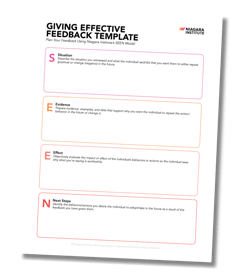Constructive Feedback Resources
Resources to Help You Give and Receive Constructive Feedback in the Workplace
Download the Constructive Feedback Planner PDF Template
As the bestselling author of the book, Freakonomics, Steven Levitt once said, “The key to learning is feedback. It is nearly impossible to learn anything without it.” Yet, the thought of delivering constructive feedback can keep many up at night. In a survey of over 7,000 people, it was found that 44% of managers find delivering constructive feedback stressful or difficult, with 21% altogether avoiding it.
Even with our own fears, anxiety, and discomfort in giving constructive feedback, those around us want - and need it. Most people would rather know where they stand and fix the issue than wait for it to escalate to the point where there are consequences all because someone was afraid to give them feedback. This was highlighted in a Harvard Business Review survey, where 92% of the respondents agreed with the assertion, “Negative feedback if delivered appropriately, is effective at improving performance.”
Delivering feedback is foundational in coaching employees and building the manager-employee relationship. The goal of coaching employees is to uncover and develop their potential, and development takes place through constructive feedback.
Gallup describes the benefits of the manager-employee coaching relationship as, “Coaches understand, leverage, and get great satisfaction from deploying the unique talents and strengths of each employee. Great managers are always developing and positioning talent to maximize outcomes, and they get extraordinary results from it: Workers who know and use their strengths average 10% to 19% increased sales and 14% to 29% increased profit, among other bottom-line results.”
The value that comes from meaningful conversations with employees that go beyond project updates cannot be dismissed. It is the frequent conversations on skill development, performance, and ongoing feedback that help employees see the progress they’re making in improved results and goal attainment.



%20(1).png?width=1920&height=1080&name=How%20to%20Use%20the%20SEEN%20Feedback%20Model%20(+Template)%20(1).png)
%20(1).png?width=1920&height=1080&name=How%20To%20Give%20Feedback%20Employees%2c%20Peers%2c%20and%20Boss%20(+Template)%20(1).png)
.png?width=1920&height=1080&name=Good%20Feedback%20vs%20Bad%20Feedback%20Examples%20(1).png)
.png?width=1920&height=1080&name=What%20is%20Employee%20Feedback%20%20(1).png)

.png?width=1920&height=1080&name=Feedback%20Training%20(1).png)

.png?width=1920&height=1080&name=40+%20Professional%20Feedback%20Examples%20for%20Work%20(1).png)